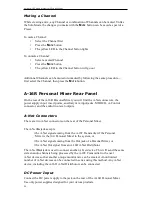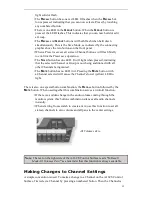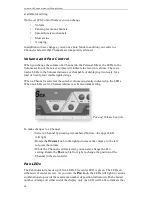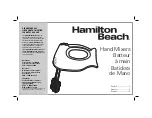
Aviom A-16 Personal Monitor Mixing System
42
43
used. Since many mixing boards provide direct channel outputs, we’ll use that output
for example purposes.
If you have a mixer without direct outputs, you can substitute audio coming from
any available output of your mixer. That includes the main outputs, bus outputs, aux
sends, or insert points.
Connect the direct outputs from your main mixing board channels to the A-16T
Transmitter’s inputs. For simplicity, connect the channels in an easy to remember
order. If the lead vocal is plugged into Channel 1 of your main mixing board, con-
necting it to Input 1 on the A-16T makes it easy to check connections.
For illustration purposes, let’s assume that you have eight audio signals connected
from your main mixing board to the A-16T, and that they are plugged into Inputs 1
through 8 on the rear panel of the A-16T.
A-16T Front Panel Settings
For the basic setup example, set all the Input Level switches on the front panel of the
A-16T to the 0dB setting. Next, check that all Link switches are in the left position
(meaning that the channels are not linked). The examples will assume that you are
using mono audio signals.
Audio Connections — Outputs
Plug headphones or in-ear monitors into the A-16R Personal Mixer’s front panel
Headphone jack. If you use powered floor monitors, spot monitors, or wireless in-ear
monitors, connect the Line output jacks on the rear panel of the A-16R Personal
Mixer to the inputs of your audio device.
Before powering up the system, turn the Master Volume control on the Personal
Mixer to its minimum setting (full left) to ensure that unwanted high-volume audio is
not accidentally sent into your monitors when the system is powered up. The Master
Volume control is on the right side of the Personal Mixer, next to the Bass and Treble
controls.
If you are using the A-16CS Control Surface, make sure that the A-Control cable is
connected and that the Remote/Local switch on the front panel of the A-16R is in the
R
EMOTE
position.
Labeling the Channels
The A-16R Personal Mixer and the A-16CS Control Surface have a convenient label
strip right on the front panel.
Use a china marker (sometimes called a “grease pencil”) to write the name of the
instrument or audio source appearing on each Channel’s label area.
Optionally, you could also write a performer’s name on the label strip marking area
to identify Channels.
















































